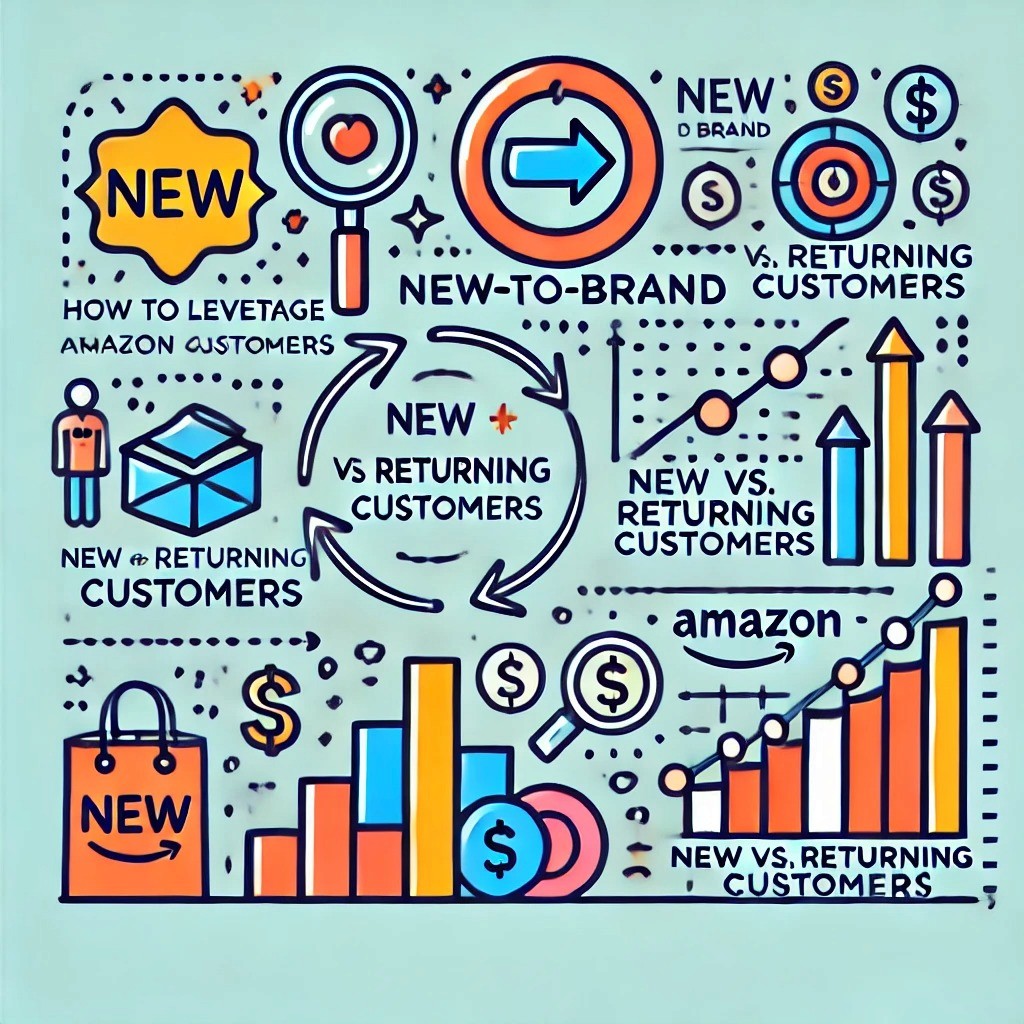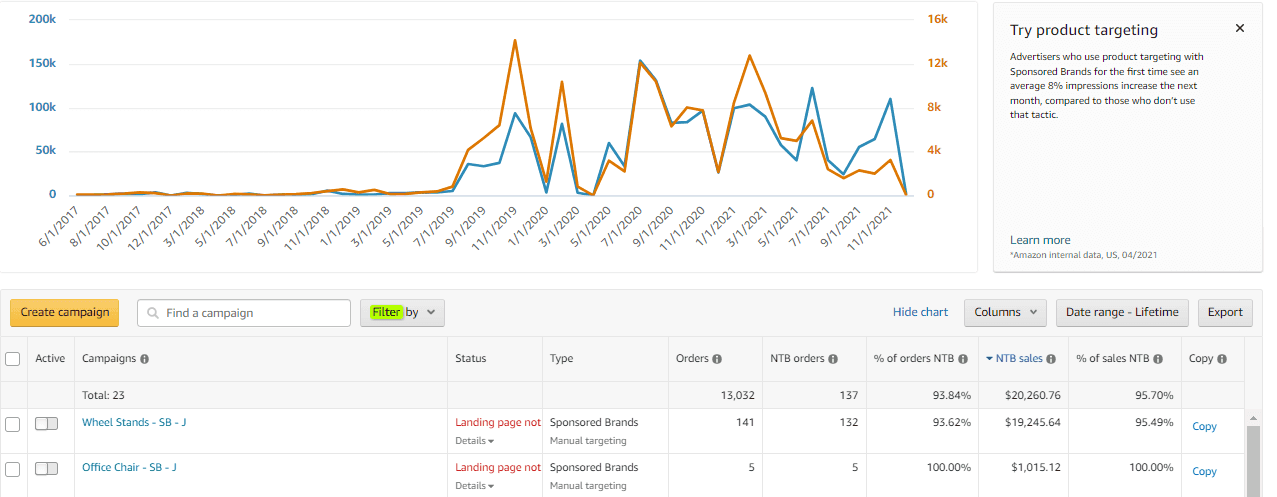Back to Page
Amazon Tips
How To Leverage Amazon’s New-To-Brand Metrics To Track New vs. Returning Customers
How To Leverage Amazon’s New-To-Brand Metrics To Track New vs. Returning Customers


Back to Page
Amazon Tips
How To Leverage Amazon’s New-To-Brand Metrics To Track New vs. Returning Customers

Dec 4, 2021
In November 2018, Amazon launched new-to-brand metrics that help advertisers determine the effectiveness of their ad campaigns in gaining new customers vs. retaining existing customers. Historically advertisers lacked the visibility needed to determine if the ad attributes purchase was made by a new or existing shopper. But to compete against already-established giants like Facebook and Google, Amazon is constantly trying to beef up its advertising platform.
Even though it’s been three years since this new group of metrics was launched, a lot of sellers are not aware of its true potential. As a result, they are missing out on crucial information that can help them better plan and optimize their advertising campaigns.
A quick recap of new-to-brand metrics
New-to-brand metrics answer one of the most important questions: Are my campaigns driving new customers to the brand, or they’re getting more repeat purchases? As of now, new-to-brand metrics are only available for one type of ad: Sponsored Brand Ads. These metrics can be used by brand-registered sellers (through Seller Central), vendors (through the advertising platform Amazon Marketing Services (AMS), and advertisers using DSP (for Amazon property websites, not for 3rd-party sites).
To find new-to-brand metrics, click on “Add metric” above the graph and select the NTB metrics. If a shopper has not purchased from your brand within the last 12 months, the order will be considered new to the brand. New-to-brand metrics can be viewed within your campaign performance dashboard and can also be extracted in report formats for display and video advertisers.
Advertisers will get performance metrics such as:


New-to-to-brand orders: The total number of orders on Amazon that are acquired by a brand from a new-to-brandcustomer over a one-year look-back window from the present date.
Percentage of new-to-brand orders: The percentage of total orders of advertised products that are purchased by new-to-brand customers.
New-to-brand sales: The total sales (in the local currency) of new-to-brand orders.
Percentage of new-to-brand sales: The percentage of total sales (in the local currency) of new-to-brand orders.
Related post: Amazon New-To-Brand Metrics: All The Facts
How to analyze new-to-brand metrics?
It’s pretty simple. If your NTB% is high, it means that new customers are coming to your brand and if our NTB% is low, it means you’ve successfully retained your existing customer base. Both situations are desirable, but it all depends on your campaign goals and whether you would like to increase or decrease your NTB%. The campaigns that have high NTB% contain products and keywords that attract new users, so they are more likely to steer shoppers away from the competitors and toward your brand. The campaigns with low NTB% should contain brand-related keywords. This will prevent our competitors from stealing your shoppers using your brand name.
The data available from new to-brand metrics also help answer why your ads might have a high ACOS. If your NTB% and ACOS are both high, then it is acceptable because your advertising efforts are introducing new customers to your brand.
Applying New-to-Brand Metrics to Advertising Campaigns
You can never choose between driving new customers and retaining existing customers – you need both. However, you can plan, create, and run a campaign focused on brand awareness or customer retention and allocate budget/set bids based on the campaign goal.
Tip from our Amazon marketing consultant: If your brand has fewer customers, it is advisable to run more campaigns focused on brand awareness, and if your brand is well established or at a growing stage, running a customer retention campaign can help create a loyal customer base.
1) Reach new customers (brand awareness)

If your advertising goal is to reach more new-to-brand orders, you should target high search volume keywords. This helps maximize the visibility and reach of your ads. Make sure you set high bids to ensure your ads will be displayed. Keep in mind that because you are targeting highly competitive keywords, your conversion rates will be ACOS will be high.
2) Reach existing customers (customer retention)

If your advertising goal is to reach customers who are familiar with your brand, launch a campaign with branded keywords. These types of keywords have low impressions and clicks but high conversion because only the customers who are interested in buying your product will search for your brand.
Advertisers and Amazon PPC experts can also use new-to-brand metrics in product launch campaigns. Looking at the metrics can help you determine how many of your existing customers chose to buy your newly launched product. But make sure such campaigns are product-specific only, or the data can be misleading because the KPIs are available at a campaign level and not at the ASIN level.
Final thoughts
New-to-brand metrics are of great use to everyone – big brands who want to cash on their existing customers and growing brands who want to expand their customer base and brand awareness. Despite having access to such advanced metrics, most advertisers and Amazon seller consultants are unaware of the existence of this new metric or choose not to leverage it to their benefit. With this blog post, we hope you can better understand and take advantage of this valuable data and gauge the effectiveness of your ads in attracting new customers or retaining existing customers.
Need planning on how to utilize new-to-brand metrics in your Sponsored Brand campaigns? Our Amazon consultants can help. Being one of the Top Amazon PPC Agencies, you can benefit from our in-depth specialist knowledge and tried and tested strategies to drive growth in your advertising campaigns.
In November 2018, Amazon launched new-to-brand metrics that help advertisers determine the effectiveness of their ad campaigns in gaining new customers vs. retaining existing customers. Historically advertisers lacked the visibility needed to determine if the ad attributes purchase was made by a new or existing shopper. But to compete against already-established giants like Facebook and Google, Amazon is constantly trying to beef up its advertising platform.
Even though it’s been three years since this new group of metrics was launched, a lot of sellers are not aware of its true potential. As a result, they are missing out on crucial information that can help them better plan and optimize their advertising campaigns.
A quick recap of new-to-brand metrics
New-to-brand metrics answer one of the most important questions: Are my campaigns driving new customers to the brand, or they’re getting more repeat purchases? As of now, new-to-brand metrics are only available for one type of ad: Sponsored Brand Ads. These metrics can be used by brand-registered sellers (through Seller Central), vendors (through the advertising platform Amazon Marketing Services (AMS), and advertisers using DSP (for Amazon property websites, not for 3rd-party sites).
To find new-to-brand metrics, click on “Add metric” above the graph and select the NTB metrics. If a shopper has not purchased from your brand within the last 12 months, the order will be considered new to the brand. New-to-brand metrics can be viewed within your campaign performance dashboard and can also be extracted in report formats for display and video advertisers.
Advertisers will get performance metrics such as:


New-to-to-brand orders: The total number of orders on Amazon that are acquired by a brand from a new-to-brandcustomer over a one-year look-back window from the present date.
Percentage of new-to-brand orders: The percentage of total orders of advertised products that are purchased by new-to-brand customers.
New-to-brand sales: The total sales (in the local currency) of new-to-brand orders.
Percentage of new-to-brand sales: The percentage of total sales (in the local currency) of new-to-brand orders.
Related post: Amazon New-To-Brand Metrics: All The Facts
How to analyze new-to-brand metrics?
It’s pretty simple. If your NTB% is high, it means that new customers are coming to your brand and if our NTB% is low, it means you’ve successfully retained your existing customer base. Both situations are desirable, but it all depends on your campaign goals and whether you would like to increase or decrease your NTB%. The campaigns that have high NTB% contain products and keywords that attract new users, so they are more likely to steer shoppers away from the competitors and toward your brand. The campaigns with low NTB% should contain brand-related keywords. This will prevent our competitors from stealing your shoppers using your brand name.
The data available from new to-brand metrics also help answer why your ads might have a high ACOS. If your NTB% and ACOS are both high, then it is acceptable because your advertising efforts are introducing new customers to your brand.
Applying New-to-Brand Metrics to Advertising Campaigns
You can never choose between driving new customers and retaining existing customers – you need both. However, you can plan, create, and run a campaign focused on brand awareness or customer retention and allocate budget/set bids based on the campaign goal.
Tip from our Amazon marketing consultant: If your brand has fewer customers, it is advisable to run more campaigns focused on brand awareness, and if your brand is well established or at a growing stage, running a customer retention campaign can help create a loyal customer base.
1) Reach new customers (brand awareness)

If your advertising goal is to reach more new-to-brand orders, you should target high search volume keywords. This helps maximize the visibility and reach of your ads. Make sure you set high bids to ensure your ads will be displayed. Keep in mind that because you are targeting highly competitive keywords, your conversion rates will be ACOS will be high.
2) Reach existing customers (customer retention)

If your advertising goal is to reach customers who are familiar with your brand, launch a campaign with branded keywords. These types of keywords have low impressions and clicks but high conversion because only the customers who are interested in buying your product will search for your brand.
Advertisers and Amazon PPC experts can also use new-to-brand metrics in product launch campaigns. Looking at the metrics can help you determine how many of your existing customers chose to buy your newly launched product. But make sure such campaigns are product-specific only, or the data can be misleading because the KPIs are available at a campaign level and not at the ASIN level.
Final thoughts
New-to-brand metrics are of great use to everyone – big brands who want to cash on their existing customers and growing brands who want to expand their customer base and brand awareness. Despite having access to such advanced metrics, most advertisers and Amazon seller consultants are unaware of the existence of this new metric or choose not to leverage it to their benefit. With this blog post, we hope you can better understand and take advantage of this valuable data and gauge the effectiveness of your ads in attracting new customers or retaining existing customers.
Need planning on how to utilize new-to-brand metrics in your Sponsored Brand campaigns? Our Amazon consultants can help. Being one of the Top Amazon PPC Agencies, you can benefit from our in-depth specialist knowledge and tried and tested strategies to drive growth in your advertising campaigns.
In November 2018, Amazon launched new-to-brand metrics that help advertisers determine the effectiveness of their ad campaigns in gaining new customers vs. retaining existing customers. Historically advertisers lacked the visibility needed to determine if the ad attributes purchase was made by a new or existing shopper. But to compete against already-established giants like Facebook and Google, Amazon is constantly trying to beef up its advertising platform.
Even though it’s been three years since this new group of metrics was launched, a lot of sellers are not aware of its true potential. As a result, they are missing out on crucial information that can help them better plan and optimize their advertising campaigns.
A quick recap of new-to-brand metrics
New-to-brand metrics answer one of the most important questions: Are my campaigns driving new customers to the brand, or they’re getting more repeat purchases? As of now, new-to-brand metrics are only available for one type of ad: Sponsored Brand Ads. These metrics can be used by brand-registered sellers (through Seller Central), vendors (through the advertising platform Amazon Marketing Services (AMS), and advertisers using DSP (for Amazon property websites, not for 3rd-party sites).
To find new-to-brand metrics, click on “Add metric” above the graph and select the NTB metrics. If a shopper has not purchased from your brand within the last 12 months, the order will be considered new to the brand. New-to-brand metrics can be viewed within your campaign performance dashboard and can also be extracted in report formats for display and video advertisers.
Advertisers will get performance metrics such as:


New-to-to-brand orders: The total number of orders on Amazon that are acquired by a brand from a new-to-brandcustomer over a one-year look-back window from the present date.
Percentage of new-to-brand orders: The percentage of total orders of advertised products that are purchased by new-to-brand customers.
New-to-brand sales: The total sales (in the local currency) of new-to-brand orders.
Percentage of new-to-brand sales: The percentage of total sales (in the local currency) of new-to-brand orders.
Related post: Amazon New-To-Brand Metrics: All The Facts
How to analyze new-to-brand metrics?
It’s pretty simple. If your NTB% is high, it means that new customers are coming to your brand and if our NTB% is low, it means you’ve successfully retained your existing customer base. Both situations are desirable, but it all depends on your campaign goals and whether you would like to increase or decrease your NTB%. The campaigns that have high NTB% contain products and keywords that attract new users, so they are more likely to steer shoppers away from the competitors and toward your brand. The campaigns with low NTB% should contain brand-related keywords. This will prevent our competitors from stealing your shoppers using your brand name.
The data available from new to-brand metrics also help answer why your ads might have a high ACOS. If your NTB% and ACOS are both high, then it is acceptable because your advertising efforts are introducing new customers to your brand.
Applying New-to-Brand Metrics to Advertising Campaigns
You can never choose between driving new customers and retaining existing customers – you need both. However, you can plan, create, and run a campaign focused on brand awareness or customer retention and allocate budget/set bids based on the campaign goal.
Tip from our Amazon marketing consultant: If your brand has fewer customers, it is advisable to run more campaigns focused on brand awareness, and if your brand is well established or at a growing stage, running a customer retention campaign can help create a loyal customer base.
1) Reach new customers (brand awareness)

If your advertising goal is to reach more new-to-brand orders, you should target high search volume keywords. This helps maximize the visibility and reach of your ads. Make sure you set high bids to ensure your ads will be displayed. Keep in mind that because you are targeting highly competitive keywords, your conversion rates will be ACOS will be high.
2) Reach existing customers (customer retention)

If your advertising goal is to reach customers who are familiar with your brand, launch a campaign with branded keywords. These types of keywords have low impressions and clicks but high conversion because only the customers who are interested in buying your product will search for your brand.
Advertisers and Amazon PPC experts can also use new-to-brand metrics in product launch campaigns. Looking at the metrics can help you determine how many of your existing customers chose to buy your newly launched product. But make sure such campaigns are product-specific only, or the data can be misleading because the KPIs are available at a campaign level and not at the ASIN level.
Final thoughts
New-to-brand metrics are of great use to everyone – big brands who want to cash on their existing customers and growing brands who want to expand their customer base and brand awareness. Despite having access to such advanced metrics, most advertisers and Amazon seller consultants are unaware of the existence of this new metric or choose not to leverage it to their benefit. With this blog post, we hope you can better understand and take advantage of this valuable data and gauge the effectiveness of your ads in attracting new customers or retaining existing customers.
Need planning on how to utilize new-to-brand metrics in your Sponsored Brand campaigns? Our Amazon consultants can help. Being one of the Top Amazon PPC Agencies, you can benefit from our in-depth specialist knowledge and tried and tested strategies to drive growth in your advertising campaigns.









